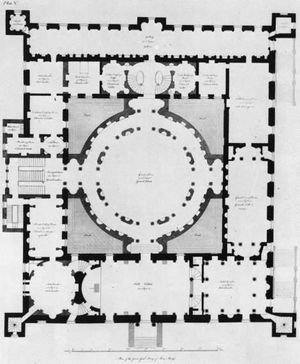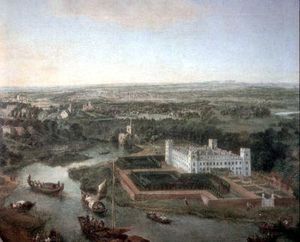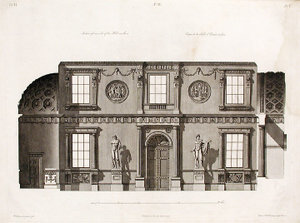Syon House
From Wikipedia, the free encyclopedia

Syon House and its 200 acre (800,000 m²) park is situated in southwest London, in England. It belongs to the Duke of Northumberland and is now his family's London residence. The family's traditional central London residence was Northumberland House.
Originally the site of a medieval abbey of the Bridgettine Order, Syon was named after Mount Zion in the Holy Land. One of the last great abbeys to be built, it was founded by King Henry V in 1415, and dissolved by King Henry VIII in 1539. In 1547, King Henry VIII's coffin was brought to Syon on its way to Windsor for burial. It burst open during the night and in the morning dogs were found licking up the remains! This was regarded as a divine judgement for the King's desecration of Syon Abbey.
After dissolution, the estate came into the possession of the 1st Duke of Somerset, Lord Protector to young Edward VI. Between 1547 and his death by execution in 1552, the Duke built Syon House in the Italian Renaissance style, over the foundations of the west end of the huge abbey church. The square house seen today is hollow in the middle, and was built around the convent's cloister garden, although this is not proven and extremely unlikely given the recent archaeological evidence that the west end of Syon House is built over the western end of the church.
Syon was then acquired by a rival, John Dudley, Duke of Northumberland. The Duke's son Lord Guildford Dudley had married Lady Jane Grey, the great-granddaughter of King Henry VII, and it was at Syon that she was formally offered the Crown. In 1594, Henry Percy, 9th Earl of Northumberland acquired Syon through his marriage to Dorothy Devereux, and the Percy family has lived at Syon House ever since.
In 1750, Sir Hugh Smithson inherited the Percy estates through his wife Elizabeth Seymour. In 1750, Sir Hugh became Earl and then 1st Duke of Northumberland in 1766. The Duke and Duchess were determined to make their mark on Syon Park; their solution was to completely redesign the estate.
Robert Adam was instructed to remodel the interior of Syon House, and Capability Brown to lay out the grounds. In 1761, Adam published his plan for the interior decoration of Syon House, which included a complete suite of rooms on the principal level, together with a rotunda to be erected in the main courtyard. In the event, five main rooms on the west, south and east sides of the House, from the Great Hall to the Long Gallery were refurbished in the Neo-classical style. It was enough to place a stamp on the architect and his work in England and it is said "at Syon the Adam style was actually initiated". Syon House is feted as Adam's early English masterpiece and has been recognised as the finest surviving evidence of his revolutionary use of colour.
'Syon Park borders the Thames, looking across the river to Kew Gardens, and near its banks is a tidal meadow flooded twice a day by the river. It contains over 200 species of rare trees. Although the park and lake were designed by Capability Brown in 1760, their character today is nineteenth century. The circular pool has a copy of Giambologna's Mercury. The Great Conservatory in the gardens, designed by Charles Fowler in 1828 and completed in 1830, was the first conservatory to be built from metal and glass on a large scale. The conservatory was shown in a dream sequence in Meera Syal's 1993 film Bhaji on the Beach.
Henry Percy, 11th Duke of Northumberland who was head of the family from 1988 to 1995, was noted for planting many trees in the grounds of Syon.
In 2002, the English poet Geoffrey Hill released a booklength poem, "The Orchards of Syon", to much aclaim. "The Orchards of Syon", focuses on the history of the region and in particular on the orchard of rare trees first planted in Syon Abbey.
[edit] See also
- Alnwick Castle - the principal seat of the Dukes of Northumberland.
- Northumberland House - the former central London residence of the Dukes of Northumberland.



